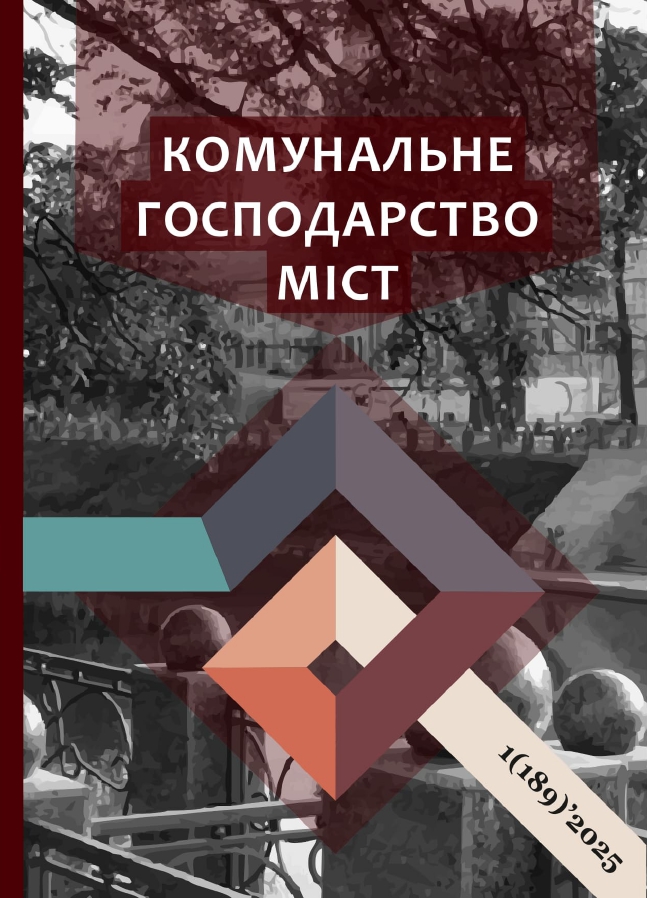МЕТОДИКА ВИБОРУ АЛЬТЕРНАТИВНИХ ДЖЕРЕЛ ЕНЕРГІЇ ПРИ ТЕПЛОЕНЕРГЕТИЧНІЙ РЕНОВАЦІЇ БУДИНКІВ
DOI:
https://doi.org/10.33042/2522-1809-2025-1-189-503-512Ключові слова:
альтернативні джерела енергії, термомодернізація будівель, тепловий насос, системи опалення будинківАнотація
В даній статті запропоновано методику вибору альтернативних джерел енергії для систем теплопостачання будинків при проведенні заходів при їх реновації з метою зменшити енергоспоживання та викиди вуглецю в навколишнє середовище. Методика спирається на визначенні індексів енергоефективності будівлі для визначення оптимального варіанту впровадження. Розглянуто приклад втілення запропонованої методики для учбового корпусу університету.
Посилання
IEA. Tracking Clean Energy Progress 2023: Assessing critical energy technologies for global clean energy transitions. 2023, Available online: https://www.iea.org/reports/tracking-clean-energy-progress-2023 (accessed 09.04.2025).
IEA. Net Zero Roadmap: A Global Pathway to Keep the 1.5 °C Goal in Reach; International Energy Agency: Paris 2023, Available online: https://www.iea.org/reports/net-zero-roadmap-a-global-pathway-to-keep-the-15-0c-goal-in-reach, (accessed 09.04.2025).
DESA, UN. (2019). United Nations, Department of Economic and Social Affairs, Population Division. World Urbanization Prospects: The 2018 Revision (ST/ESA/SER.A/420). New York: United Nations. https://population.un.org/wup/assets/WUP2018-Report.pdf (accessed 09.04.2025)
Bianchi, G., Panayiotou, G. P., Aresti, L., Kalogirou, S. A., Florides, G. A., Tsamos, K., Tassou, S. A., & Christodoulides, P. (2019). Estimating the waste heat recovery in the European Union Industry. Energy, Ecology and Environment, 4(5), 211-221. https://doi.org/10.1007/s40974-019-00132-7
Mahmoud, M., Ramadan, M., Naher, S., Pullen, K., & Olabi, A.-G. (2021). The impacts of different heating systems on the environment: A review. Science of The Total Environment, 766, 142625. https://doi.org/https://doi.org/10.1016/j.scitotenv.2020.142625
Guzović, Z., Duic, N., Piacentino, A., Markovska, N., Mathiesen, B. V., & Lund, H. (2022). Recent advances in methods, policies and technologies at sustainable energy systems development. Energy, 245, 123276. https://doi.org/https://doi.org/10.1016/j.energy.2022.123276
Lerbinger, A., Petkov, I., Mavromatidis, G., & Knoeri, C. (2023). Optimal decarbonization strategies for existing districts considering energy systems and retrofits. Applied Energy, 352, 121863. https://doi.org/https://doi.org/10.1016/j.apenergy.2023.121863
Taheri, S., Hosseini, P., & Razban, A. (2022). Model predictive control of heating, ventilation, and air conditioning (HVAC) systems: A state-of-the-art review. Journal of Building Engineering, 60, 105067. https://doi.org/https://doi.org/10.1016/j.jobe.2022.105067
Cholewa, T., Siuta-Olcha, A., Smolarz, A., Muryjas, P., Wolszczak, P., Guz, Ł., Bocian, M., Sadowska, G., Łokczewska, W., & Balaras, C. A. (2023). On the forecast control of heating system as an easily applicable measure to increase energy efficiency in existing buildings: Long term field evaluation. Energy and Buildings, 292, 113174. https://doi.org/https://doi.org/10.1016/j.enbuild.2023.113174
Anđelković, A. S., & Bajatović, D. (2020). Integration of weather forecast and artificial intelligence for a short-term city-scale natural gas consumption prediction. Journal of Cleaner Production, 266, 122096. https://doi.org/https://doi.org/10.1016/j.jclepro.2020.122096
Kitzberger, T., Kotik, J., & Pröll, T. (2022). Energy savings potential of occupancy-based HVAC control in laboratory buildings. Energy and Buildings, 263, 112031. https://doi.org/https://doi.org/10.1016/j.enbuild.2022.112031
Lin, G., Casillas, A., Sheng, M., & Granderson, J. (2023). Performance Evaluation of an Occupancy-Based HVAC Control System in an Office Building. Energies, 16(20). https://doi.org/10.3390/en16207088
Valančius, K., Grinevičiūtė, M., & Streckienė, G. (2022). Heating and Cooling Primary Energy Demand and CO2 Emissions: Lithuanian A+ Buildings and/in Different European Locations. Buildings, 12(5), 570. https://www.mdpi.com/2075-5309/12/5/570
Mišík, M., Oravcová, V., & Vicenová, R. (2024). Energy efficiency of buildings in Central and Eastern Europe: room for improvement. Energy Efficiency, 17(4), 32. https://doi.org/10.1007/s12053-024-10215-y
Pater, S. (2019). Field measurements and energy performance analysis of renewable energy source devices in a heating and cooling system in a residential building in southern Poland. Energy and Buildings, 199, 115-125. https://doi.org/https://doi.org/10.1016/j.enbuild.2019.06.057
KT-Energy, L. (2018). District Heating in Ukraine: Improving the performance of District Heating Systems in Central and Eastern Europe. https://keepwarmeurope.eu/countries-in-focus/ukraine/english/ (accessed 09.04.2025)
Geletukha, G., Kramar, V., Oliynyk, Y., & Antonenko, V. (2019). Analysis of the possibilities for savings and development of district heating systems in Ukraine. Thermophysics and Thermal Power Engineering, 41(1), 53-58. https://doi.org/10.31472/ttpe.1.2019.7
Gebrail, G., Jordan-Tank, M., & Tvedt, K. (2018). 1086 Policy paper on infrastructure – Making district heating happen: empowering users through fair metering. https://solarthermalworld.org/wp-content/uploads/2021/03/making-district-heating-happen-empowering-users-through-fair-metering-en.pdf (accessed 09.04.2025)
Fialko, N. M., Tymchenko, N. P., & Sherenkovskiy, J. V. (2020). Fourth Generation of District Heating and Centralized Heating Supply Systems of Ukraine. Proceedings of CEE 2019, Cham. https://doi.org/10.1007/978-3-030-27011-7_10
Trier, D., Nielsen, J., Sorensen, A., Le Denn, A., Miedaner, O., Pauschinger, T., & Schubert, M. (2012). Solar district heating Guidelines–Collection of fact sheets. Intelligent Energy–Europe. https://www.solar-district-heating.eu/wp-content/uploads/2018/06/SDH-Guidelines_update_09.2017.pdf (accessed 09.04.2025)
Polyvianchuk, A., Malyarenko, V., Semenenko, R., Gura, K., Varbanov, P. S., & Arsenyeva, O. (2023). The general-purpose approach for estimation of residential heating systems efficiency using the various energy sources. Energy and Buildings, 296, 113390. https://doi.org/https://doi.org/10.1016/j.enbuild.2023.113390
##submission.downloads##
Опубліковано
Як цитувати
Номер
Розділ
Ліцензія
Автори, які публікуються у цьому збірнику, погоджуються з наступними умовами:
- Автори залишають за собою право на авторство своєї роботи та передають журналу право першої публікації цієї роботи на умовах ліцензії CC BY-NC-ND 4.0 (із Зазначенням Авторства – Некомерційна – Без Похідних 4.0 Міжнародна), котра дозволяє іншим особам вільно розповсюджувати опубліковану роботу з обов'язковим посиланням на авторів оригінальної роботи та першу публікацію роботи у цьому журналі.
- Автори мають право укладати самостійні додаткові угоди щодо неексклюзивного розповсюдження роботи у тому вигляді, в якому вона була опублікована цим журналом (наприклад, розміщувати роботу в електронному сховищі установи або публікувати у складі монографії), за умови збереження посилання на першу публікацію роботи у цьому журналі.
- Політика журналу дозволяє і заохочує розміщення авторами в мережі Інтернет (наприклад, у сховищах установ або на особистих веб-сайтах) рукопису роботи, як до подання цього рукопису до редакції, так і під час його редакційного опрацювання, оскільки це сприяє виникненню продуктивної наукової дискусії та позитивно позначається на оперативності та динаміці цитування опублікованої роботи (див. The Effect of Open Access).

